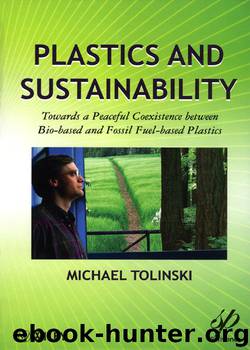Plastics and Sustainability by Tolinski Michael;

Author:Tolinski, Michael;
Language: eng
Format: epub
ISBN: 818539
Publisher: Wiley
Published: 2011-11-11T16:00:00+00:00
Automotive plastics and sustainability (4.4). Lightweight plastics for improving fuel efficiency
Recycled plastics and end-of-vehicle-life issues
Bio-based plastics in the automotive industry
Specialized applications and plastics sustainability (4.5). Electrical/electronics applications
Medical plastics and packaging
Agricultural applications
Conclusions about sustainable plastics applications (4.6).
Part 4: Searching for Real World Examples
Guy Winston is pursuing his research on sustainable plastics in many ways. He can’t help but notice that the plastics industry magazines are crammed with announcements about the latest bio-based resins or products, with one company after another implying via the trade press that it is “outgreening” its competitors. They make it sound as if the whole industry has already overtaken SureShot Inc. in the race to be green. Slightly less prevalent are all the companies bragging about recycled content in their plastics applications. Sometimes these applications are unimpressive, as in taking a post-consumer material that had been used in a high-end application and downcycling it into a relatively low-end product, such as parking lot curbs.
Daily, he faces an information glut about bioplastics and recycling, though not all of the information is clear and useful. Bioresin manufacturers’ websites have some useful background about applications, but Guy senses there’s a great deal of “greenwashing” going on, with manufacturers cherry-picking their research — emphasizing only those studies that show their products are green. They’re also sometimes unclear about exactly what proportion of their material or product is bio-based — or worst of all — omit or obscure important details about the recyclability, biodegradability, processing, cost, or availability of their products. With suppliers of recycled resins, sometimes companies don’t make clear whether their recycled content isn’t simply clean post-industrial scrap rather than truly recycled post-consumer material. It also often isn’t clear when a recycled material’s lower properties mean that more material (and greater cost) results when it’s used in an application.
Guy does find some useful books and conference presentations about green plastics, but often these either are too general to be useful or have too much of a research emphasis, focusing in-depth on materials or processes that, chances are, will never become commercially viable. For more of a real-world view, Guy looks at the questions and comments at social networking sites and online industry forum groups. But despite the good industry knowledge of the online participants, there’s still too much “bad” to sort through: misunderstood or ill-defined terms, self-serving responses, exaggerations, contradictions, and biased opinions. (And the opinions are both positive and negative towards bioplastics — including a few discussion group postings Guy was surprised to find from both his director of engineering Sheila Wolfe and his boss Paul Kirmidgin.) Guy finds little synthesis of ideas online, though at least he starts to understand who the players in the bioresin game are, as well as the general interests and attitudes of his industry colleagues and what applications they are interested in pursuing.
Coincidentally during this process Guy received a phone call from an old colleague who now works in a company that injection-molds engineering plastics for electronics and automotive parts. The old friend
Download
This site does not store any files on its server. We only index and link to content provided by other sites. Please contact the content providers to delete copyright contents if any and email us, we'll remove relevant links or contents immediately.
| Concrete | Extraction & Processing |
| Fracture Mechanics | Materials Science |
| Metallurgy | Polymers & Textiles |
| Strength of Materials | Testing |
Whiskies Galore by Ian Buxton(41525)
Introduction to Aircraft Design (Cambridge Aerospace Series) by John P. Fielding(32885)
Small Unmanned Fixed-wing Aircraft Design by Andrew J. Keane Andras Sobester James P. Scanlan & András Sóbester & James P. Scanlan(32570)
Craft Beer for the Homebrewer by Michael Agnew(17930)
Turbulence by E. J. Noyes(7694)
The Complete Stick Figure Physics Tutorials by Allen Sarah(7135)
Kaplan MCAT General Chemistry Review by Kaplan(6591)
The Thirst by Nesbo Jo(6432)
Bad Blood by John Carreyrou(6271)
Modelling of Convective Heat and Mass Transfer in Rotating Flows by Igor V. Shevchuk(6219)
Learning SQL by Alan Beaulieu(6030)
Weapons of Math Destruction by Cathy O'Neil(5824)
Man-made Catastrophes and Risk Information Concealment by Dmitry Chernov & Didier Sornette(5643)
Digital Minimalism by Cal Newport;(5388)
Life 3.0: Being Human in the Age of Artificial Intelligence by Tegmark Max(5182)
iGen by Jean M. Twenge(5158)
Secrets of Antigravity Propulsion: Tesla, UFOs, and Classified Aerospace Technology by Ph.D. Paul A. Laviolette(4982)
Design of Trajectory Optimization Approach for Space Maneuver Vehicle Skip Entry Problems by Runqi Chai & Al Savvaris & Antonios Tsourdos & Senchun Chai(4837)
Electronic Devices & Circuits by Jacob Millman & Christos C. Halkias(4743)
